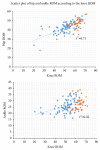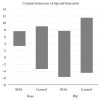Effects of Knee Osteoarthritis on Hip and Ankle Gait Mechanics
- PMID: 31019809
- PMCID: PMC6451827
- DOI: 10.1155/2019/9757369
Effects of Knee Osteoarthritis on Hip and Ankle Gait Mechanics
Abstract
Introduction: Knee osteoarthritis (OA) can affect the hip and ankle joints, as these three joints operate as a kinetic/kinematic chain while walking.
Purpose: This study was performed to compare (1) hip and ankle joint gait mechanics between knee OA and control groups and (2) to investigate the effects of knee gait mechanics on the ipsilateral hip and ankle joint.
Methods: The study group included 89 patients with end-stage knee OA and 42 age- and sex-matched controls without knee pain or OA. Kinetic and kinematic parameters were evaluated using a commercial optoelectric gait analysis system. Range of motion (ROM) during gait, coronal motion arc, and peak joint moment of hip, knee, and ankle joints were investigated.
Results: Ankle varus moment was 50% higher in the OA group (p=0.005) and was associated with higher knee adduction moment (p<0.001). The ROM of the hip and ankle joints were significantly smaller in the OA group and were associated with limited ROM of the knee joint (both p<0.001). The coronal motion arc of the hip was smaller in the OA group and was also associated with limited motion arc of the knee (p<0.001).
Conclusions: Knee OA has a negative effect on the ROM, coronal motion arc, and joint moment of the ankle joint and hip joint. As knee OA is associated with increased moment of the ankle joint, attention should be paid to the ankle joint when treating patients with knee OA.
Figures



Similar articles
-
Hip, Knee, and Ankle Osteoarthritis Negatively Affects Mechanical Energy Exchange.Clin Orthop Relat Res. 2016 Sep;474(9):2055-63. doi: 10.1007/s11999-016-4921-1. Epub 2016 Jun 10. Clin Orthop Relat Res. 2016. PMID: 27287859 Free PMC article.
-
Effect of end-stage hip, knee, and ankle osteoarthritis on walking mechanics.Gait Posture. 2015 Sep;42(3):373-9. doi: 10.1016/j.gaitpost.2015.07.005. Epub 2015 Jul 17. Gait Posture. 2015. PMID: 26213184
-
Slow gait speed after bilateral total knee arthroplasty is associated with suboptimal improvement of knee biomechanics.Knee Surg Sports Traumatol Arthrosc. 2018 Jun;26(6):1671-1680. doi: 10.1007/s00167-017-4682-8. Epub 2017 Aug 28. Knee Surg Sports Traumatol Arthrosc. 2018. PMID: 28849392
-
Contributions to the understanding of gait control.Dan Med J. 2014 Apr;61(4):B4823. Dan Med J. 2014. PMID: 24814597 Review.
-
Does Gait Retraining Have the Potential to Reduce Medial Compartmental Loading in Individuals With Knee Osteoarthritis While Not Adversely Affecting the Other Lower Limb Joints? A Systematic Review.Arch Rehabil Res Clin Transl. 2019 Sep 5;1(3-4):100022. doi: 10.1016/j.arrct.2019.100022. eCollection 2019 Dec. Arch Rehabil Res Clin Transl. 2019. PMID: 33543053 Free PMC article. Review.
Cited by
-
Decision-making factors and their thresholds for total knee arthroplasty in lateral tibiofemoral osteoarthritis patients: a retrospective cohort study.Knee Surg Relat Res. 2022 Oct 23;34(1):41. doi: 10.1186/s43019-022-00168-w. Knee Surg Relat Res. 2022. PMID: 36274181 Free PMC article.
-
Exploring the potential of the sit-to-stand test for self-assessment of physical condition in advanced knee osteoarthritis patients using computer vision.Front Public Health. 2024 Feb 7;12:1348236. doi: 10.3389/fpubh.2024.1348236. eCollection 2024. Front Public Health. 2024. PMID: 38384889 Free PMC article.
-
The Interplay of Biomechanical and Biological Changes Following Meniscus Injury.Curr Rheumatol Rep. 2023 Feb;25(2):35-46. doi: 10.1007/s11926-022-01093-3. Epub 2022 Dec 7. Curr Rheumatol Rep. 2023. PMID: 36479669 Free PMC article. Review.
-
Association between Foot Posture Asymmetry and Static Stability in Patients with Knee Osteoarthritis: A Case-Control Study.Biomed Res Int. 2020 Jun 5;2020:1890917. doi: 10.1155/2020/1890917. eCollection 2020. Biomed Res Int. 2020. PMID: 32596282 Free PMC article.
-
The impact of neck pain on gait health: a systematic review and meta-analysis.BMC Musculoskelet Disord. 2023 Jul 29;24(1):618. doi: 10.1186/s12891-023-06721-2. BMC Musculoskelet Disord. 2023. PMID: 37516827 Free PMC article.
References
-
- Vos T., Barber R. M., Bell B. Global, regional, and national incidence, prevalence, and years lived with disability for 301 acute and chronic diseases and injuries in 188 countries, 1990–2013: a systematic analysis for the Global Burden of Disease Study 2013. The Lancet. 2013;386(9995):743–800. - PMC - PubMed
LinkOut - more resources
Full Text Sources
Medical
Research Materials

